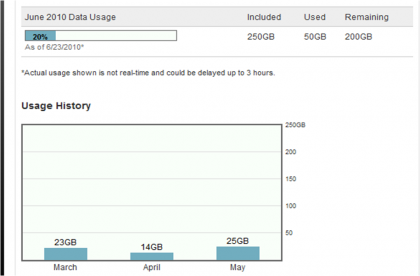While I still don’t come close to the Comcast bandwidth cap of of 250 GB per month, I’ve noticed a significant increase in my household’s broadband usage since Roku pushed out their new Netflix UI. The new interface makes it easy to browse content by genre, and, most critically, allows users to play any selection instantly without first queuing it up on a PC. As a direct result, I’ve started watching more – the short-lived Dresden Files and the first season of Friday Night Lights, for example. Take a look at the spike on my household’s Comcast bandwidth meter. June usage already doubles May, and we’re not at the end of the month yet.

It’s worth noting that the UI upgrade didn’t arrive without problems. Right after the update, the new Netflix app crashed often; an issue the company gracefully managed by offering users an unsolicited 5% credit toward the next month’s bill. I’ve since heard a plausible if unconfirmed explanation of what caused the difficulties, namely the fact that the new guide requests a lot more data during subscriber usage, which initially put a strain on the delivery system.
Difficulties initially? Problems are going on three weeks for me and many others. Especially in the evening which is probably due to high usage. Still, they need to fix it.
Tom
Tom- I’ve had no problems at all since the initial trouble. Maybe it’s your ISP?
“As a direct result, I’ve started watching the short-lived Dresden Files and the first season of Friday Night Lights.”
I find it very difficult to believe that your bandwidth spike has to do with what the Roku Netflix UI is consuming rather than the fact that you seem to be simply watching more Netflix.
The bandwidth consumed by HD Video streaming in a minute dwarfs anything I can imagine the Roku UI consuming in an hour…
Chucky – Yes, the better UI means that I watch more Netflix, which means I use more bandwidth. I am not suggesting that the UI by itself is causing the spike.
“means that I watch more Netflix”
If you’ve got the proper in-house infrastructure, Netflix HD streaming absolutely does rock.
At 9 bucks a month, it’s a better deal than any non-HBO cable channel.
i hate double-posting.
No worries there… certain expletives automatically land comments in the moderation queue. And I just came across yours. I would have let it through, but looks like you’ve got it covered with an almost dupe. :)
I’m still having problems too. Over the last week or so I see the problem has gotten worse. Last night it told me that an epsisode of Kidnapped was not available. After a few tries the episode came on. Then almost immediately afterwards, quality went from HD down ro 2 dots. It’s not uncommon for a 4 dot quality to lose a dot during play. The quality problem is happening more frequently. It’s not my cable operator.
“It’s not my cable operator.”
Assuming you aren’t on FIOS, it may very well be your cable operator. None of the IP over coax providers seem to be able to deliver their advertised bandwidth on a constant basis during periods when your neighbors are also consuming heavy bandwidth.
And even if it isn’t your cable operator, how is your in-home infrastructure done? You either need wired ethernet to your Netflix capable box, or a well-performing 5ghz radio with a clear line of sight to your Netflix capable box to get the necessary bandwidth on a constant basis.
Netflix HD streaming really does rock, but only if you’ve got the proper infrastructure to get the necessary video over IP bandwidth at your TV on a constant basis. And most folks simply don’t have that, even if they think they do.
(Of course, I don’t have a Roku – I use a TiVo as my Netflix interpreter – so perhaps the Roku has problems of its own beyond my imagining. But given the bandwidth demands of streaming HD, it seems more likely that the problem lies with your cableco or your in-home infrastructure. And given that I get a rock-solid signal from Netflix, I don’t think it possible that the problem lies with Netflix itself, either.)
My new Vizio 42″ HDTV has Netflix and it features the ability to browse titles and add them to my Instanr Queue. Definitely better than the TiVo implementation that only permits you to play titles already in the instant Queue.
“It’s not my cable operator.” – Good comments but here’s my finding.
I’m a Systems Analyst who has covered all those bases and more, Comcast cable (3800 Kbps as baseline), wired cat6 to Roku player, in-depth research to optimize my router settings for streaming, shrinking the configuration profile of my Roku player by removing unused stream sources…. and I would have been first in line to encourage other Roku customers to do the same as the cure to their presumed ills since all those steps helped me. That is…. until the latest firmware build was force pushed onto customers this weekend, and for now, not only does it look like my days of HD streaming are over (HD unsupportable and SD sources barely loadable as well), but after all I’ve done to optimize, after all my own cheerleading, this latest usability issue pushed me personally past the threshold at last, and I can’t take this on any more as a major project – it’s just a consumer appliance and I must move on. My 2- and 3-dot appliance which rebuffers and can’t reload a simple SD movie is probably going to the garage sale table, as I shop for a more stable solution. If end users had control over the selection and timing of the firmware updates, it would be a different matter – but we don’t.